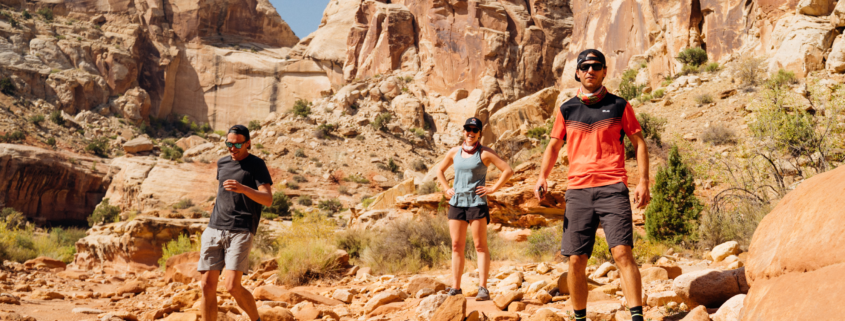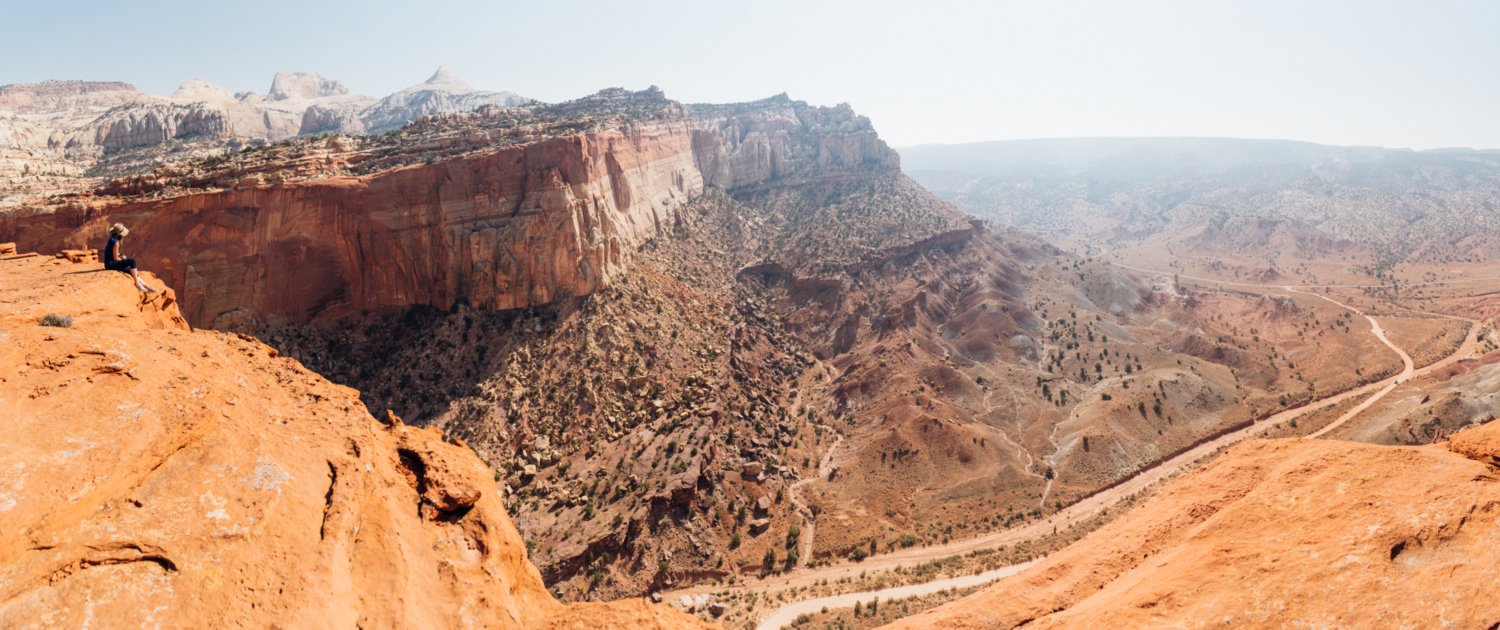The Hiking Essentials Gear Guide & Packing List
This Day Hiking Essentials Gear Guide comes from the minds of former guides and avid travelers and adventurers. It will give you valuable information, insight, and recommendations to help you prepare for day hiking in any destination for any adventure that awaits you.
Just need a packing list? Scroll down to the bottom of the blog!
Day Hiking Essentials Gear Guide
Footwear:
Choosing the right footwear is super important. Comfortable kicks often mean fewer blisters and more time outside doing what you want to do. You have three general options to choose from when it comes to footwear – hiking boots, hiking shoes, and trail runners. Choose what makes the most sense for your adventure. We personally love getting these fitted in a store with the help of a retail salesperson so that we can make sure they fit properly.
- Hiking Boots: Heavier and more durable. For anyone who wants the most ankle support and stability. There are waterproof and more breathable options.
- Hiking Shoes: More lightweight and flexible than boots, suitable for less demanding terrain or those carrying less weight.
- Trail Runners: Ultra lightweight, super grippy, for those who prioritize lightweight footwear. We don’t recommend this to anyone who is new to hiking.
- Socks: Choose moisture-wicking, cushioned socks made of wool or synthetic materials to prevent blisters. No cotton because they don’t dry quickly and encourage blisters.
Clothing:
No Hiking Essentials Gear Guide is complete without an explanation of the layering system.
When it comes to clothing there are two golden rules – don’t wear cotton and use the layering system whose only purpose is to keep you as dry as possible at all times which ultimately keeps you comfortable and safe from the elements. Why? Because when cotton gets wet, it takes a long time to dry and doesn’t retain heat like other fabrics do. Using the layering system is an awesome way to keep your body temp under control because as you warm up, you can pull layers off, and as you get cold, you can put layers back on.
How To Use The Layering System:
We like using a light base layer ( anything next to skin), a light insulating layer, a warmer “jacket”, and a shell (for rain protection). Whether you’re playing during summer or in winter, you can add thicker base layers and more insulation layers to help you regulate your body temperature more efficiently. As temps get colder, you add layers, as they get warmer you remove them. Combine layers for whatever keeps you the most comfortable.
- Moisture-Wicking Base Layers: Opt for lightweight, breathable shirts and pants that wick away sweat and keep you dry. This is your first layer – it can be a t-shirt, long johns, etc.
- Hiking Pants/Shorts: Durable, quick-drying pants or shorts with multiple pockets for storing essentials. We like pants with stretch material for greater range of motion and comfort.
- Insulating Layers: These are layers with built in insulation – it can be a light fleece jacket or it can be an insulated down or synthetic jacket. Its purpose is to keep you warm. You could have multiple of these – a light fleece and an insulated puffy for colder temps. The more layers you have, the more you can dial in your systems.
- Waterproof Jacket: Invest in a high-quality, waterproof and windproof jacket to protect against rain and wind. This is your external layer/ armor to protect you from the elements – just like a crab that carries its shell around, this is a layer that keeps you safe and comfy.
Backpacks:
Daypack: If you’re looking to have decision fatigue, walk into your local outdoors shop and look at the day pack selections. What we look for are packs that are 20- 30 liters (later is okay, just cumbersome if they’re too big) so that we have space for a water bladder, snacks, and a few layers. We also like daypacks with hip belts and a few zippers for organization. If you’re an ultra light kind of adventurer – you could consider using a running vest/ pack.
Navigation:
One of our favorite ways is to use mapping apps that work with your phone’s GPS – but we NEVER solely rely on our electronic devices since batteries and phones do die unexpectedly (yikes). If you’re doing a trip into more remote regions you may need to get some education surrounding navigation with a map, GPS device and compass.
Here are our favorite apps to use for navigation:
- All Trails: for easy planning and navigation phone
- Gaia : for backcountry expeditions
Hydration & Filtration
- Water Bottles/Reservoir: We love using our hiking bladders but we usually carry an additional bottle in case your bladder springs a leak. We buy the biggest bladders we can because the weight penalty isn’t very big and we love having more water when needed.
- Water Filter or Purification Tablets: We love bringing along a lightweight filter or purification system when we know we’ll be crossing bodies of water (or even if we don’t). This is such a great tool to keep you hydrated when everything is going right and especially when things are going wrong.
Nutrition & Hydration Products:
No Hiking Essentials Gear Guide is complete without a mention of the stuff that you put in your body – which is just as important as what you put on it.
- Trail Snacks: Pack lightweight, high-energy snacks like granola bars, nuts, dried fruits, or energy gels for quick energy boosts.
- Meals: For longer hikes, bring dehydrated or freeze-dried meals that require minimal preparation. On super long days of playing outside, we sometimes opt to use a small butane stove with us to boil water and to eat a proper meal. You pour boiling water right into the bag, stir, close, and wait 15 or so minutes. We won’t lie, some of these are so good you could probably eat them at home. And if that’s not your cup of tea, a packed lunch is still a good option.
- Hydration powder, chews, or tablets: When you’re sweating all day, you lose valuable electrolytes that keep your body functioning at its peak. These products are AWESOME to bring on adventures and there are so many brands to choose from. We love the chews and the tablets (that go into water bottles) that replenish your electrolytes.
Sun Protection:
We think it goes without saying that protecting yourself from the sun is super important. The essentials that we always keep on our packing lists are:
- Sunscreen: Use a high SPF, broad-spectrum sunscreen and reapply regularly. We carry small sunscreen sticks in the pockets of our backpack so that we always have them handy.
- Hat: We always bring some kind of hat on our adventures. Whether a wide-brimmed hat to shield your face and neck from the sun or a baseball cap we like anything that we can easily throw in the wash.
- Sunglasses: Protect your eyes from UV rays with sunglasses that offer good coverage. We love polarized sunglasses and those with interchangeable lenses for versatility in variable lighting conditions.
- Sunshirt: One of our favorite ways to protect from the sun is to cover up. A lightweight long sleeve shirt with a hoodie is one of the best tools in our kit to protect us from the sun.
Safety and First Aid Essentials & Gear Guide
Bringing a first aid kit is no substitute for first aid training. Besides the essential gear below that we carry, taking a wilderness first aid course gives you tools to know what to do when things go wrong. Here are some basics that we bring with us on EVERY adventure. You can check out “survival” gear that often have most of the following in them.
- First Aid Kit: Carry a basic first aid kit with essentials like bandages, antiseptic wipes, pain relievers, and any personal medications. Includes water purification tablets.
- Emergency Whistle: Have a whistle to signal for help in case of an emergency.
- Multi-tool/Knife: A versatile tool can be handy for various tasks on the trail.
- Emergency blanket: A small packable and lightweight blanket that could save your life if you need to stay warm. You can wrap this around you like a blanket, or use it near a fire to help reflect heat toward you. This is essential.
- Lighter or waterproof matches: to start a fire for warmth, signals, cooking or water purification.
- Tracking Device: Ideally this is a dedicated GPS tracker that you can use as a signal in case of emergency, but at the very least, we bring a fully charged phone with us.
Lighting Essentials Gear Guide
- Headlamp/Flashlight: We like carrying a lightweight headlamp and extra batteries for all our adventures. We even keep a few spares in our personal vehicles.
Miscellaneous:
- Trekking Poles: One of our favorite tools on the trail – helps you get up and down the mountain and increases stability, especially on challenging terrains or when carrying a heavy backpack.
Hiking Essentials Packing List:
Clothing
- Moisture-wicking shirts (long-sleeve and short-sleeve)
- Hiking pants/shorts
- Insulating layers (fleece jacket, down vest, etc.)
- Waterproof and windproof jacket
- Underwear and socks (synthetic or wool)
- Hat for sun protection
- Gloves or mittens (depending on weather conditions)
- Bandana or buff
Footwear Essentials
- Hiking boots or shoes (broken in and appropriate for terrain)
- Hiking socks (moisture-wicking and blister-resistant)
Backpack Gear and Essentials
- Backpack suitable for the duration of your hike
- Plastic bags or waterproof liners (to protect gear from rain)
- Waterproof backpack cover
- Map and compass or GPS device
- Whistle (for emergencies)
- Multi-tool or knife
- Trekking poles (optional but recommended)
- Headlamp or flashlight with extra batteries
- Extra plastic bags (for waste disposal)
- Ziplock bags (for storing small items)
Food and Water Essentials
- Water bottles or hydration reservoir (2-3 liters capacity)
- Water filter or purification tablets
- Lightweight and high-energy snacks (trail mix, energy bars, jerky, etc.)
- Meals or meal replacement options (depending on trip duration)
Navigation and Safety Gear Essentials
- Digital or paper map of the area
- Compass or GPS device
- First aid kit (including band-aids, gauze, pain relievers, etc.)
- Insect repellent and/or bug net
- Emergency shelter or lightweight tarp
- Firestarter (matches, lighter, or firestarter kit)
- Bear spray (if hiking in bear country)
Personal Care
- Toiletries (toothbrush, toothpaste, biodegradable soap, etc.)
- Quick-dry towel
- Hand sanitizer
- Toilet paper or tissue
- Personal medications and any necessary prescriptions
- Sunscreen (high SPF) and lip balm
- Sunglasses with UV protection
Optional Extras
- Camera and spare batteries
- Binoculars
- Field guide or nature identification book
- Trekking Poles
- Repair kit (duct tape, safety pins, sewing kit, etc.)
- Camp shoes or sandals (for relaxing at camp)
If you enjoyed this Hiking Essentials Gear Guide, check our more posts on our blog.






